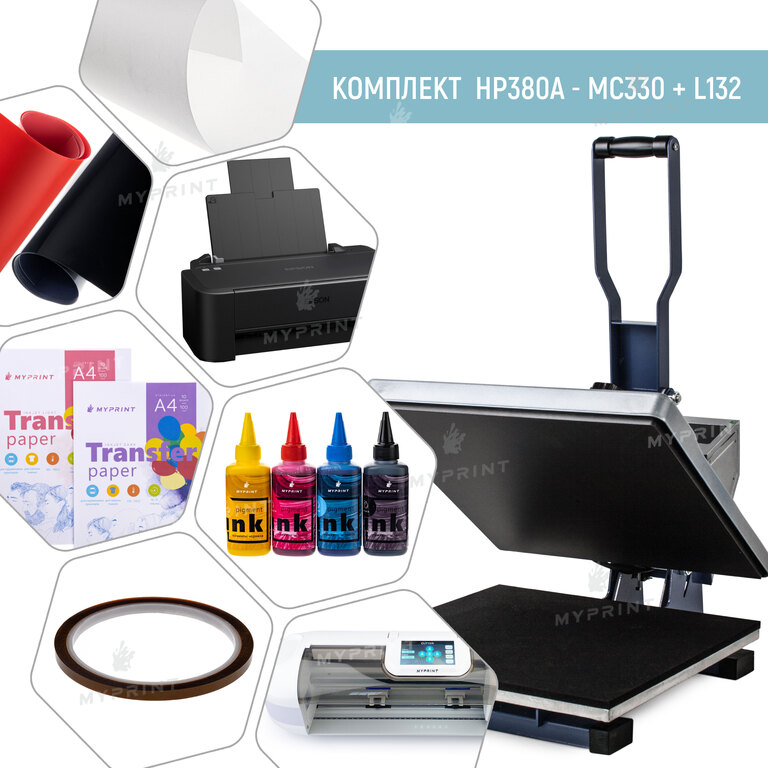Sets of equipment for thermal transfer
Thermal Transfer Printing: Features of Thermal Transfer
Thermal transfer is a fast and efficient method of placing decorative prints on the surface of various materials. Clothing items, hats, accessories, and dishware are used as a base for applying the image. Thermal transfer printing allows for the depiction of a company logo, a striking photo print, or a humorous or provocative phrase on any product.
Advantages of the method
- Color accuracy. Thermal printing looks bright and colorful on any background.
- Image detail. Thermal transfer allows for full-color, high-resolution images without blurring or loss of photographic quality.
- Versatility. Images can be applied to surfaces of any shape, even hard-to-reach areas.
- Cost-effectiveness. This method is significantly cheaper than direct printing, while still maintaining high quality.
- High productivity. Decorating one product takes less than 2 minutes.
- Wide range of applications. Thermal printing can be used on a variety of materials, from fabric to ceramics.
- Durability. The print is resistant to wear and tear, maintaining its shape even with intensive use for 2-3 years.
The stages of thermal transfer process
Before starting the thermal transfer process, a preparatory stage is necessary. First, the image is formed using specialized computer programs. If necessary, the background and unnecessary elements that do not need to be displayed on the finished product are removed from the original image.
The next stage of thermal transfer is printing the image on paper. When printing, it is important to set the correct scale, taking into account the technological allowances of 1-2 mm on the edges of the thermal transfer paper (film). The image printed on an inkjet printer should be dried for 10 minutes.
The base for the future product is placed in a thermal press. When performing thermal transfer onto fabric, for dark textiles, it is necessary to separate the paper from the backing. The image is applied face down and covered with a backing. For light textiles, the backing is not separated, and the paper with the image is applied to the fabric. Additionally, the work is covered with a Teflon backing, which prevents the photo print from sticking.
Truly high-quality and durable prints are obtained only when all production conditions are followed. The pressure force, processing temperature, and holding time depend on the color and structure of the material of the workpiece. Thermal paper manufacturers also indicate the allowable thermal transfer modes on the packaging or in the instructions. For fabrics, the indicators can vary within 150-200 degrees and 10-20 seconds. Higher temperature and longer holding time are required for light fabrics than for dark ones.
Choosing equipment for thermal transfer
An inkjet printer is recommended as the equipment for printing workpieces. It allows for obtaining a high-quality and detailed image, unlike a laser printer. It is advisable to choose models with 4-6 basic colors. The quality of pigment ink for the printer affects the brightness and saturation of the printed image.
The peculiarity of thermal transfer is that it is indirect printing on the product. Intermediate materials, such as thermal transfer paper and film, are used to apply the image. The paper consists of two parts: the bottom is the backing, and the top is the film. The service life of the finished product depends on the quality of the materials.
The transfer from the intermediate carrier to the product being decorated is carried out in a special device - a thermal press. The operation is performed under the influence of high temperatures and powerful pressure. When choosing a thermal press, it is necessary to match the distance between the bases of the device and the predicted thickness of the decorated product.
Thus, special equipment allows transferring images to various products using intermediate materials and high-temperature action. The demand for thermal printing is due to the accessibility of the method, quality, and operational properties of finished products. A set of equipment for thermal transfer can be purchased from MyPrint. Qualified specialists will provide detailed information on the features of technical means, devices, and materials for thermal transfer.
FAQ about "Thermal transfer equipment sets":
Top products in the Thermal Transfer Equipment Sets category:
- A set of equipment for thermal transfer with flatbed thermal press HP230B, plotter MC330, printer Epson L132
- A set of equipment for thermal transfer with flatbed thermal press HP380A, plotter MC330, printer Epson L132
- A set of equipment for thermal transfer with flatbed thermal press HP450A, plotter MC330, printer Epson L1300
- Set of equipment for sublimation with a tablet thermopress HP230B + L132
- Tablet thermopress HP230B 23*30
We suggest you familiarize yourself with the offers from the following categories:
We recommend paying attention to the following products:



